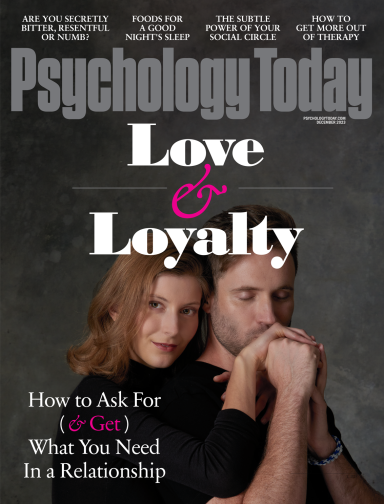Anger
How to Make the World a Better Place
It’s the only way to be consistently happy.
Posted March 12, 2014
A great crisis of our times is failure to realize that we have a drive to make the world we live in a better place.
All animals have a drive to make their environment better, albeit, applied to other animals, “better” just means safer, more comfortable, or pleasurable. For humans, the term also means fairer and more moral.
Of course, “better” is a relative term, sometimes confused with “great” or “good” or “acceptable.” Because we’re highly limited in making the world we live in great or good or even acceptable, we lose sight of the need to make it better.
Yet the smallest ways of making the world better can ultimately be the most potent, by virtue of the butterfly effect, where the smallest change in one part of the ecosystem affects large changes in other parts. The psychological mechanism of the butterfly effect is composed of the fundamental ways that social animals, including humans, communicate and cooperate: modeling, emotional display, and mimicry.
Modeling is simply exhibiting the behavior the modeler expects others to adopt. Although the evidence for the power of modeling is copious in animals, we underestimate its global influence on human behavior. We universally condemn hypocrisy, indeed are repulsed by it and consider it a form of betrayal, because it violates the implicit trust we place in modeling.
Emotional display is made up of the non-linguistic manifestations of emotions. In humans, it’s predominantly facial expressions, body language, and vocalizations. These comprise measurable vehicles of emotional contagion, noted by Hatfield, Cacioppo, and Rapson, among others, where emotions of two or more people converge and are passed from person to person in larger groups. Emotions are more contagious than any known virus.
Without mimicry, it’s doubtful that any social animals who rely on cooperation could survive. It provides predictability in social contexts. In humans, it’s most noticeable in its violation, as when someone shouts, sings, or disrobes in a restaurant. Mimicry is measurable in studies of social groups and nears a swarming effect in moving crowds, e.g., subway passengers approaching an escalator in rush hour can easily be manipulated to follow a graduate student in a less direct path to the escalator.
Personal Happiness: Model Improve, Appreciate, Connect, Protect
If you don’t model what you want from others, i.e., be the kind of person you most want others to be, you are likely to mimic what you don’t want, grow defensive and highly reactive, with a great chance of becoming the very thing you despise. Think of how often you have seen people exhibit the very behaviors they condemn in others. Virtually all abusers perceive themselves to have been abused or exploited.
By the time we’re adults, most of our emotional reactions have become habituated; on autopilot, we react the same in similar social contexts and physiological, mental, and emotional states, over and over. Habits are formed by repeated focus and behavioral activation. Therefore, it's crucial to focus on what you want to model and practice the behaviors you want others to mimic. A formula for establishing new habits is available here.
Improve
Human beings have a drive to improve. We function at our best when trying to improve and begin to lose meaning and purpose, health and wellbeing when we stop trying to improve.
Improve means striving to make something better. Think of improving as an incremental process—making things a little better at a time. People sometimes stop trying to improve because they don’t know how to “fix” a situation, i.e., make it completely better. In emotionally charged conditions, it’s nearly impossible to go directly from feeling bad to 100% improvement—feeling good. But once you make something 10% better, it becomes easier to make it 20% better. Then it’s easier to make it 40% better, and so on.
Types of improvement:
• Situational: Try to make the situation you’re in more beneficial, productive, or convenient.
• Experiential: Try to make your experience more comfortable, pleasant, or pleasurable
• Transcendent: Try to make your situation and/or your experience more meaningful.
Try a little experiment. Note your current emotional state. Count to five, then read aloud the following improve behaviors:
• Learn
• Grow
• Enhance
• Expand
• Analyze
• Build
• Repair
• Renew
• Redeem
Now note your current emotional state, after reading the above list aloud, you should find a slight elevation just from saying the words. Imagine the effect of enacting the behaviors.
N.B. It's impossible to improve when focused on how bad things are or on who's fault it is that they're so bad. We have to choose between blame and improvement, because we can't really do both.
Protect
Protection of valued persons is a fundamental survival instinct. In fact, the primary function of anger and aggression in humans is not self-protection, as you might think. Imagine what would make you angrier—if I were to attack you or your children. The instinct to protect loved ones generally overrides self-protection—most people would risk their lives to protect their children.
Elements of protection:
• Nurture
• Reassure
• Encourage
• Support
• Show love and affection
Appreciate
It’s well documented that we live in an era of sensory and information overload. Lost in the glare of gross-information and hyper-stimulation is the transcendent emotional state of appreciation.
Although we have a great deal more to appreciate with far less daily hardship and suffering than most of our ancestors, people report that they experience relatively little appreciation in their lives.
Appreciation requires opening your heart and allowing yourself to be enhanced by the experience of someone or something. In the act of appreciation, life means more to us; the experience of being alive seems better.
We need appreciation to:
• Regulate negative moods
• Break the stronghold of autopilot functioning
• Give life dimension, dynamics, and color
• Maintain a sense of meaning and purpose
• Make us happier
• Sustain intimate connection.
Connect
It’s ironic that in our era of massive social media networks and instant electronic access that people feel more disconnected. Through constant distraction, digital media has deepened the void of meaningful connection it was supposed to fill and made us more aware of how disconnected we are.
Why we need connection:
• Our brains are hard-wired for it—we were never a solitary species; we’re the most social of all mammals, forming the strongest and most enduring emotional bonds.
• We suffer physically and mentally from disconnection.
• We become psychotic without social cues.
Types of Connection:
• Basic humanity (compassion, kindness)
• Familial – emotional resonance with kin
• Intimate – emotional resonance and wellbeing is intertwined with another
• Spiritual – relating to something larger than the self
• Communal – identifying with a group of people, based on shared values, goals, or experiences.
For tips on how to enhance your ability to improve, appreciate, connect, and protect, i.e., make the world a better place while making yourself happier, see the Webinar.




